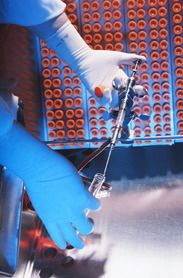Cancer is treated in a variety ways depending on the size of the tumor, its location, the type of cancer, and a host of other factors. Three common ways to treat cancer include:
- Surgery
- Radiation
- Chemotherapy (drug therapy)
In many cases, these methods are combined to get the most effective results. Let's look at each one in more detail.
Surgery
Surgery is the oldest way to treat cancer. If the tumor is relatively localized, it can be surgically removed. Often, a border of healthy tissue surrounding the tumor is also taken to ensure that all of the malignant cells have been removed. Surgery is commonly used for cancer of the breast, colon, mouth, head and neck, kidney, testes and other parts of the body. Surgery can also be used to remove tissue that may become cancerous if left untreated (precancerous) and also to relieve symptoms caused by the cancer. Surgery is often combined with chemotherapy and/or radiation to improve results.
Radiation
Radiation therapy, also know as radiotherapy, X-ray therapy, cobalt therapy, or irradiation, is useful in fighting cancer because it destroys cancer cells more easily than normal cells. Radiotherapy is commonly delivered with an external beam of x-rays, gamma rays or alpha and beta particles directed at the tumor. Radioactive pellets or wires can also be used internally if they are put in a tiny container and then implanted into the body near the tumor. In some cases, both internal and external radiation is used.
Radiation therapy is used for early Hodgkin's lymphoma, certain cancers of the lung, prostate, bladder, and other tumors. Radiation therapy is commonly used in conjunction with other therapies, including surgery and chemotherapy. For instance, radiation therapy may shrink a tumor to facilitate surgery, or be used as an adjunct after surgery to prevent the tumor from reforming. In some cases, radiation therapy is used alone, especially when the tumor is very susceptible to radiation, or when surgery to the area is too risky. Radiation can be used to shrink a tumor to provide relief from symptoms associated with tumor growth, even when a cure is highly unlikely.
Chemotherapy
Chemotherapy or drug therapy is used to kill cancer cells, while attempting to limit the damage to normal cells. Chemotherapy is useful in fighting cancer that has spread to other parts of the body and cannot be easily detected or treated with surgery or radiation therapy. Of the roughly 50 anticancer drugs, some can be used alone, or in combination with other anticancer drugs. Chemotherapy has been successful in treating acute leukemia, Hodgkin's and malignant lymphoma, small cell lung cancer, bladder and testicular cancer, and other forms of cancer. Chemotherapy can cure cancer in some cases, limit the spread of cancer, and help alleviate symptoms in some types of cancer. Chemotherapy can be used in combination with surgery and/or radiation, often with improved results.
Side Effects
Side effects from cancer treatment vary widely from person to person, and are also dependent on which type of therapy is used. Common side effects from chemotherapy include: nausea and vomiting, hair loss, fatigue, increased chance of bleeding or infection and anemia. Some potential side effects from radiation include, loss of appetite, skin changes and fatigue. Side effects from cancer surgery are similar to other types of surgery and include pain during recovery, temporary nausea from drugs used during anesthesia, and the potential for bleeding or infection after the surgery is completed. Your doctor and health care team are the best people to advise you about what side effects you can expect, and how to best manage them. There are medications, nutritional tips and other ways available to greatly reduce the impact of side effects from cancer treatment.

